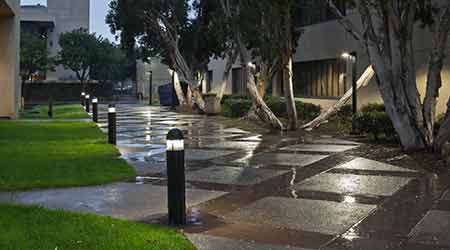 Dignity Health specified LEDs for its exterior lighting project because of their longer performance lives and maintenance benefits.Photo: Acuity Brands
Dignity Health specified LEDs for its exterior lighting project because of their longer performance lives and maintenance benefits.Photo: Acuity BrandsHospital Officials Specify LEDs for Exterior Lighting Project
Part three of a four-part article on an exterior LED upgrade at California hospital
Dignity officials spent months working to secure a vendor before selecting Acuity Brands. No matter the manufacturer, it was clear that LEDs, known for their longer life cycle and reduced impact on maintenance, would be the chief technology option for the upgraded exterior lighting system.
“The timing was right in terms of the maturity cycle as related to LEDs,” Gerner says. “If you would have asked me two or three years ago whether LEDs were ready for this kind of investment and for me to say to my providers, ‘Give me a 10-year turnkey warranty,’ I would have said most manufacturers are not there with the product yet. That has changed for us in the last few years to where I think LEDs are a mature enough technology.”
After California’s Office of Statewide Health Planning and Development approved the products, work started at St. Mary in May 2015. The contractors installed motion sensors for the parking areas and walkways along with 400 new fixtures to help lower energy use even more.
“We like the feature of the energy savings and the dimming part of it,” Garibay says. “With the photocells, the lights are going out during the day, and that also saves us quite a bit. The old system had timers, and sometimes the timers would be on during the day and burn up energy.”
The new exterior lighting system at St. Mary also curtailed maintenance time previously devoted to troubleshooting the old system, freeing up staff for other projects. Many of the projects involve the hospital’s efforts to reduce water use and comply with the state’s severe restrictions in the midst of California’s extreme drought.
The hospital does not have any time frame in mind for completing the projects, but thanks to less maintenance duties for exterior lighting, all of those projects can be addressed in a more timely fashion.
“With the water restrictions, our landscaping areas look horrible, so we’re thinking about going to artificial turf or changing the landscape to desert and drought-tolerant plants,” he says. "One of our biggest things is condensate water — recapturing it and reusing it back to our cooling tower, which can save a lot of water. There is also a limit on how long to run our sprinklers. And broken lines, they want them fixed right away, or it’s a fine or citation.”
Related Topics:















